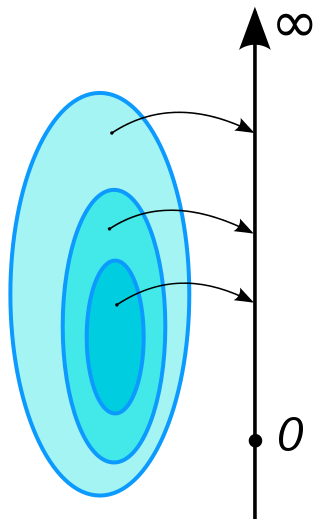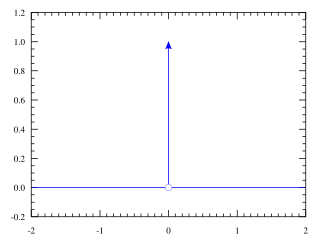In mathematics, specifically in measure theory, a Borel measure on a topological space is a measure that is defined on all open sets. Some authors require additional restrictions on the measure, as described below.

In mathematics, the concept of a measure is a generalization and formalization of geometrical measures and other common notions, such as magnitude, mass, and probability of events. These seemingly distinct concepts have many similarities and can often be treated together in a single mathematical context. Measures are foundational in probability theory, integration theory, and can be generalized to assume negative values, as with electrical charge. Far-reaching generalizations of measure are widely used in quantum physics and physics in general.

In mathematical analysis, a null set is a Lebesgue measurable set of real numbers that has measure zero. This can be characterized as a set that can be covered by a countable union of intervals of arbitrarily small total length.
In mathematical analysis and in probability theory, a σ-algebra on a set X is a nonempty collection Σ of subsets of X closed under complement, countable unions, and countable intersections. The ordered pair is called a measurable space.
In mathematical analysis, the Haar measure assigns an "invariant volume" to subsets of locally compact topological groups, consequently defining an integral for functions on those groups.
In mathematics, the Kronecker delta is a function of two variables, usually just non-negative integers. The function is 1 if the variables are equal, and 0 otherwise:
In calculus and real analysis, absolute continuity is a smoothness property of functions that is stronger than continuity and uniform continuity. The notion of absolute continuity allows one to obtain generalizations of the relationship between the two central operations of calculus—differentiation and integration. This relationship is commonly characterized in the framework of Riemann integration, but with absolute continuity it may be formulated in terms of Lebesgue integration. For real-valued functions on the real line, two interrelated notions appear: absolute continuity of functions and absolute continuity of measures. These two notions are generalized in different directions. The usual derivative of a function is related to the Radon–Nikodym derivative, or density, of a measure. We have the following chains of inclusions for functions over a compact subset of the real line:
In mathematics, the Radon–Nikodym theorem is a result in measure theory that expresses the relationship between two measures defined on the same measurable space. A measure is a set function that assigns a consistent magnitude to the measurable subsets of a measurable space. Examples of a measure include area and volume, where the subsets are sets of points; or the probability of an event, which is a subset of possible outcomes within a wider probability space.
In the mathematical field of measure theory, an outer measure or exterior measure is a function defined on all subsets of a given set with values in the extended real numbers satisfying some additional technical conditions. The theory of outer measures was first introduced by Constantin Carathéodory to provide an abstract basis for the theory of measurable sets and countably additive measures. Carathéodory's work on outer measures found many applications in measure-theoretic set theory, and was used in an essential way by Hausdorff to define a dimension-like metric invariant now called Hausdorff dimension. Outer measures are commonly used in the field of geometric measure theory.
In mathematics, more precisely in measure theory, an atom is a measurable set which has positive measure and contains no set of smaller positive measures. A measure which has no atoms is called non-atomic or atomless.
In measure theory, Carathéodory's extension theorem states that any pre-measure defined on a given ring of subsets R of a given set Ω can be extended to a measure on the σ-ring generated by R, and this extension is unique if the pre-measure is σ-finite. Consequently, any pre-measure on a ring containing all intervals of real numbers can be extended to the Borel algebra of the set of real numbers. This is an extremely powerful result of measure theory, and leads, for example, to the Lebesgue measure.
In mathematics, two positive measures and defined on a measurable space are called singular if there exist two disjoint measurable sets whose union is such that is zero on all measurable subsets of while is zero on all measurable subsets of This is denoted by
In mathematics, a positive (or signed) measure μ defined on a σ-algebra Σ of subsets of a set X is called a finite measure if μ(X) is a finite real number (rather than ∞). A set A in Σ is of finite measure if μ(A) < ∞. The measure μ is called σ-finite if X is a countable union of measurable sets each with finite measure. A set in a measure space is said to have σ-finite measure if it is a countable union of measurable sets with finite measure. A measure being σ-finite is a weaker condition than being finite, i.e. all finite measures are σ-finite but there are (many) σ-finite measures that are not finite.
In mathematics, the support of a measure on a measurable topological space is a precise notion of where in the space the measure "lives". It is defined to be the largest (closed) subset of for which every open neighbourhood of every point of the set has positive measure.
In mathematics, strict positivity is a concept in measure theory. Intuitively, a strictly positive measure is one that is "nowhere zero", or that is zero "only on points".
In mathematics, a metric outer measure is an outer measure μ defined on the subsets of a given metric space (X, d) such that
In measure theory, a branch of mathematics that studies generalized notions of volumes, an s-finite measure is a special type of measure. An s-finite measure is more general than a finite measure, but allows one to generalize certain proofs for finite measures.
In mathematics, especially measure theory, a set function is a function whose domain is a family of subsets of some given set and that (usually) takes its values in the extended real number line which consists of the real numbers and
In mathematics and information theory, Sanov's theorem gives a bound on the probability of observing an atypical sequence of samples from a given probability distribution. In the language of large deviations theory, Sanov's theorem identifies the rate function for large deviations of the empirical measure of a sequence of i.i.d. random variables.
A Markov chain on a measurable state space is a discrete-time-homogeneous Markov chain with a measurable space as state space.




























